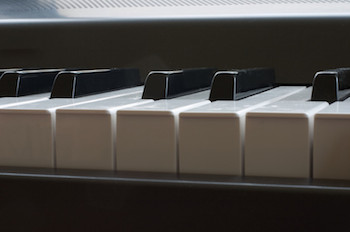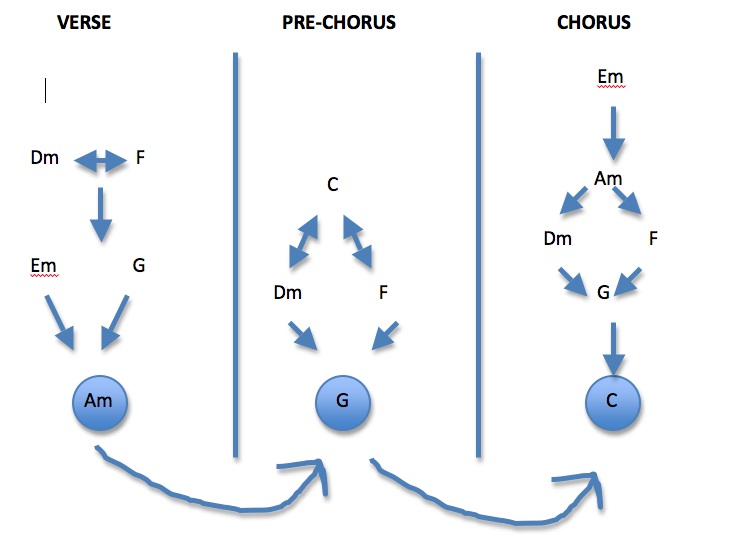Thousands of songwriters are using Gary Ewer’s “The Essential Secrets of Songwriting” 10 e-Book Bundle to solve their songwriting dilemmas. Includes “From Amateur to Ace: Writing Songs Like a Pro.” Read More..
______________
 It’s possible to write really fantastic music with very few chords. Most songs in the pop genres use only four or five separate chords:
It’s possible to write really fantastic music with very few chords. Most songs in the pop genres use only four or five separate chords:
- “Royals” (Lorde): D, C and G.
- “Girls Chase Boys” (Ingrid Michaelson): Ab, Db, Fm and Eb.
- “Rude” (Magic!): Gb, Ab, Bbm and Db
The question asked by many up-and-coming songwriters is: How do you find those chords, and how do you get them in the right order?
There are lots of ways to do it, thankfully, which keeps music interesting and songwriting fun. But if you’re really stuck, and would like to have a few hints, check out the following chord progression chart:
Here’s how it works:
- Song Form. This has been calculated for a verse-pre-chorus-chorus kind of song form, but it will also work if you decide to not use a pre-chorus.
- Creating Verse Progressions. In this formula, your verse will focus on the key of A minor. To create your progression, improvise by playing Am, then jump upward anywhere in the stack, and then make your way down as indicated by the arrows. That will give you lots of possible progressions: Am Em Am; Am Dm Em Am; Am F G Am, and so on. The chart ensures that Am remains a focus for your verse.
- Creating Pre-Chorus Progressions. Because in this plan your song chorus is going to wind up in C major, you’ll want your pre-chorus to target C major by focusing on its dominant chord: G. So that’s why G is placed prominently at the bottom, and will give you these possibilities: Dm G; F G; C/E F G; etc.
- Creating Chorus Progressions. Now improvise your chorus progressions in the same way, using C as your tonic chord.
This chart is not meant, of course, to imply that it’s the only way to create chords for a song. It’s just one suggested way of working that should yield some useful results. Feel free to experiment as much as possible, and don’t feel that you must follow the dictates of the chart.
The best use of this chart is as a starting point, getting you going in the right direction. As you generate chord ideas, you’ll probably find that your musical imagination will start filling in the blanks, and you can happily abandon the chart at that point.
Don’t forget that the chart is transposable to any key. I haven’t taken the time to use Roman numerals here, but if you want a refresher on how to transpose using Roman numerals, read this post.
______________
 Written by Gary Ewer. Follow on Twitter.
Written by Gary Ewer. Follow on Twitter.
“The Essential Secrets of Songwriting” eBook Bundle packages look at songwriting from every angle, and have been used by thousands of songwriters. How to use chords, write melodies, and craft winning lyrics. GET TODAY’S BUNDLE DEAL.











Hey, thats a great article. For me this is great, as some people are talented, they just go with it… i need the theory, and to be honest i have played guitar for years, but because of lack of theory such as the above one, im missing a lot
Pingback: A Chart For Creating Bridge Chord Progressions | The Essential Secrets of Songwriting Blog
Gary,
I love this chart. I immediately made a screen grab and added in the Roman numerals. I’m wondering, do you have a version that addresses the chords in the bridge? Also one for chord progressions in a minor key, or when the verse is minor and the chorus is major? I know you’ve written articles about those …just wondering if there are ‘cheat sheet’ charts to go with. Your blog has helped me so much. Thank you for writing it.
Hi Beth:
I don’t think I’ve specifically done one for the bridge, but I’d be interested in working one out in the coming days, possibly within the next week. Glad you’ve found it useful.
-Gary
I found it difficult to understand your explanation of the chart and how to use it.
Hi Tom:
Along with the explanation I gave sample progressions that would result from the chart. Can you tell me what part of the explanation is confusing? I’m happy to help.
-Gary
Hi Gary,
Thanks for responding 🙂
I’m really not sure what the arrows in the chart are meant to represent; how they relate to the chords that they point to. I can’t seem to see much relationship with what you describe in the text following the chart.
Also, do you mean for each section to finish on the chord in focus – i.e. the verse to finish on the Am, the pre-chorus to finish on the G and the Chorus to finish on the C?
Thanks,
Tom
Hi Tom:
The arrows are simply meant to suggest a possible direction for you as you choose your next chord. For example, in the verse chart, you could move back and forth from Dm to F, as the arrows suggest. Then you could move down to an Em, then follow the arrow down to Am.
It’s a good idea to finish each section with the chord in focus, though this isn’t a rule. At any point when the feeling hits you, you can start in on your chorus or pre-chorus. Remember, this chart wasn’t meant to be a list of rules. It was simply a guide for suggesting some of the possibilities.
Hope this helps,
-Gary
Thank you, Gary. I have a better idea of what it means now.
Reblogged this on I Write The Music.
Pingback: Interesting Links For Musicians and Songwritiers – August 22, 2014 | Creative Music | Inspiring Musical Creativity